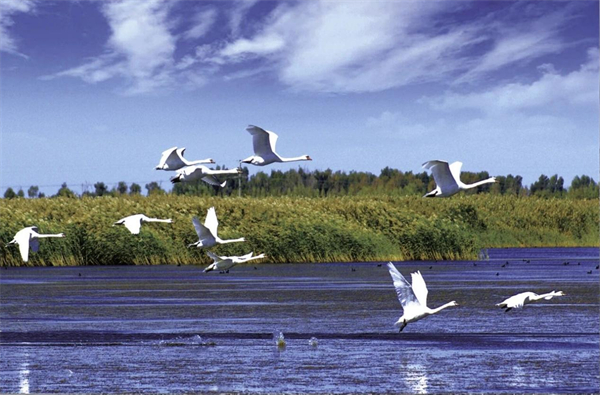Inner Mongolia achieves results in river and wetland eco-water replenishment

A flock of swans fly over Wuliangsuhai Lake. [Photo/Urad Front Banner Integrated Media Center]
In 2024, North China's Inner Mongolia autonomous region reported significant achievements in eco-water replenishment for key rivers, lakes, and wetlands. This is according to a news conference on the effectiveness of water resources projects held by the Inner Mongolia Autonomous Regional People's Government.
Hulun Lake's surface area remained stable, Wuliangsuhai Lake received 376 million cubic meters of replenished water, and Daihai Lake received 22.88 million cu m. Environmental degradation in the Chahannuur Basin was effectively curbed, and East Juyanhai Lake achieved its 20th consecutive year without drying up.
Li Bin, deputy director of the Inner Mongolia Water Resources Department, highlighted the region's unwavering commitment to ecological preservation. Measures included enhancing the "river chief and lake chief" system, with provincial leaders spearheading patrols to address 1,071 water-related issues. Key projects, such as the Daihai Lake emergency ecological water replenishment system, were integrated into this initiative.
The region also launched a "Mother River Revival" campaign, which improved ecological health and achieved notable outcomes. Soil erosion control covered 12.52 million mu (834,667 hectares), significantly reducing degradation.
Water resource investments in the region exceeded 20 billion yuan ($2.76 billion) in 2024, marking sustained growth. The "One Core, Two Wings, Three Verticals, Four Horizontals, West-to-East Transfer, and Internal-External Connections" water network also took shape.
Efforts to improve water efficiency and rural water access saw progression. Irrigation upgrades covered 1.44 million mu, maintenance of 2,657 rural water supply projects benefited 1.58 million people, and comprehensive agricultural water pricing reforms expanded by 3.75 million mu, bringing the total to 49.69 million mu.



 Print
Print Mail
Mail


